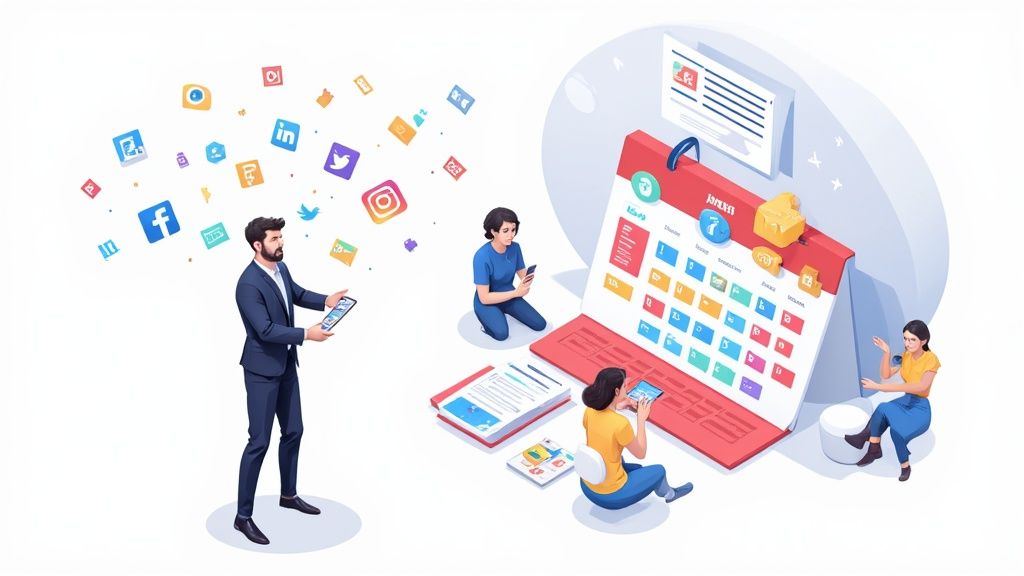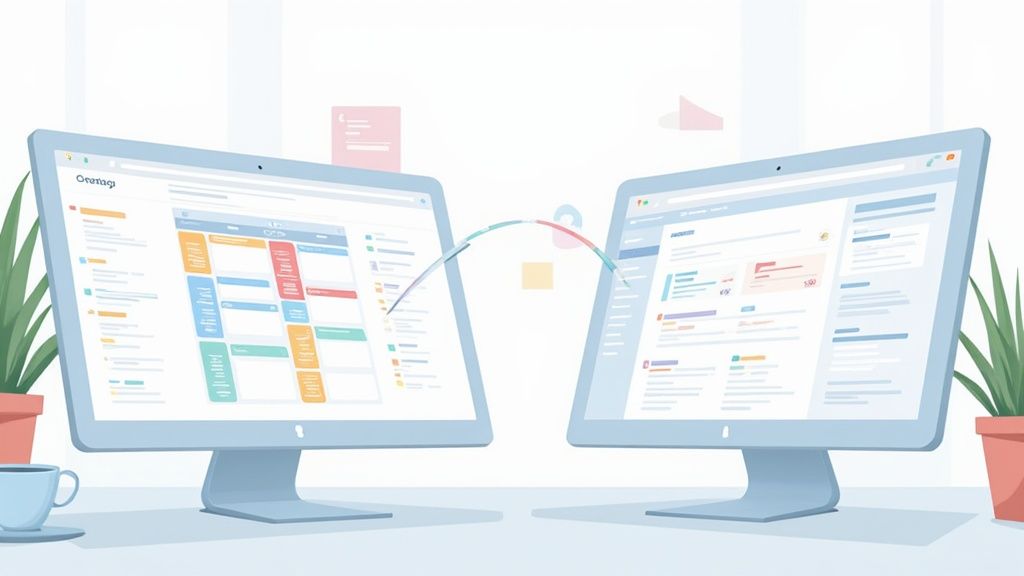In any educational or professional development setting, from a university lecture hall to a corporate training webinar, the primary challenge is the same: capturing and sustaining audience attention. Simply presenting information is no longer sufficient. Meaningful learning, retention, and application occur only when participants are actively involved, intellectually stimulated, and personally connected to the content. This is the core of student engagement, a critical factor that separates a passive, forgettable session from an impactful, memorable experience. When learners are engaged, they are not just listening; they are thinking, questioning, and collaborating, which directly translates to better comprehension and higher success rates.
This comprehensive guide moves beyond abstract theory to provide a practical toolkit of ten proven student engagement strategies. Each method is designed for immediate implementation by educators, academic coordinators, and event marketers aiming to elevate their programs. We will explore a diverse range of powerful techniques, including Active Learning, Gamification, Project-Based Learning, and Technology Integration. You will gain actionable insights into not just what these strategies are, but precisely how to apply them in your specific context. We'll provide concrete examples and step-by-step guidance to help you foster a more dynamic, participatory, and effective learning environment. This article is your roadmap to transforming passive attendees into active, enthusiastic learners.
1. Active Learning Strategies
Active learning transforms students from passive listeners into active participants in their own education. This pedagogical approach, championed by education researchers like Eric Mazur and Carl Wieman, shifts the focus from information transmission to knowledge construction. Instead of simply absorbing lectures, students engage directly with the material through problem-solving, collaborative discussions, and hands-on activities that demand critical thinking.

This method moves beyond memorization, requiring students to analyze, synthesize, and evaluate complex information. The core principle is that students learn more effectively when they are actively doing something with the content. This shift is one of the most powerful student engagement strategies available because it fosters deeper understanding, improves long-term retention, and develops essential skills like communication and teamwork. For further insights into dynamic teaching methods, consider how interactive stories for learning can transform passive reception into active engagement.
How to Implement Active Learning
Implementing active learning doesn't require a complete overhaul of your teaching style. You can integrate these techniques gradually to foster a more dynamic learning environment.
- Start Small: Begin with simple, low-risk activities. A "Think-Pair-Share" exercise, where students consider a question individually, discuss it with a partner, and then share with the class, is an excellent entry point.
- Set Clear Objectives: Ensure students understand the purpose of each activity. Clearly state what they are expected to learn or accomplish to keep them focused and motivated.
- Structure Group Work: Provide clear guidelines, roles, and time limits for collaborative tasks. This structure prevents confusion and ensures that group work remains productive and on track. For instance, in a problem-solving session, assign one student as a facilitator, another as a timekeeper, and a third as the presenter.
- Leverage Technology: Use polling software, collaborative online whiteboards, or discussion forums to facilitate real-time interaction, especially in larger classes or virtual settings. These tools can help manage and scale active participation effectively.
2. Gamification
Gamification applies game-design elements and principles in non-game contexts to boost motivation and engagement. This approach, championed by experts like Jane McGonigal and Yu-kai Chou, leverages intrinsic human desires for achievement, competition, and reward. It transforms learning tasks into compelling challenges by incorporating points, badges, leaderboards, and narrative elements, making the educational process feel more interactive and less like a chore.

By framing learning within a game-like structure, this method taps into students' natural inclinations to play and compete. It creates a low-stakes environment where failure is seen as a learning opportunity, encouraging persistence and problem-solving. This makes gamification one of the most effective student engagement strategies for turning passive learning into an active quest for knowledge, fostering both skill mastery and a positive attitude toward learning.
How to Implement Gamification
Integrating gamification can be done incrementally to build excitement without overwhelming students. The key is to connect game mechanics directly to your educational goals.
- Align with Learning Objectives: Ensure every game element serves a purpose. Points should be awarded for mastering a concept, not just for participation. A badge could signify proficiency in a specific skill, making the reward meaningful.
- Balance Competition and Collaboration: While leaderboards can motivate some, they may discourage others. Balance individual competition with team-based challenges where students must collaborate to succeed, fostering teamwork alongside personal achievement.
- Start Simple: Begin with a basic points or badge system for completing assignments or answering questions correctly. Platforms like Classcraft or CodeCombat offer ready-made systems, but you can also create your own with simple spreadsheets or classroom charts.
- Provide Meaningful Rewards: Rewards don't have to be tangible. They can include choosing the next topic, earning a "homework pass," or gaining special recognition. The goal is to offer incentives that students value and find motivating.
3. Project-Based Learning (PBL)
Project-Based Learning (PBL) shifts education from short-term memorization to long-term investigation and creation. This instructional methodology, with roots in the work of John Dewey, empowers students to gain knowledge and skills by working for an extended period to investigate and respond to an authentic, engaging, and complex question, problem, or challenge. Instead of consuming information, students become creators, problem-solvers, and collaborators.

This dynamic approach makes learning relevant and meaningful, as projects often connect to real-world issues. As seen in the innovative curricula of the High Tech High and New Tech Network schools, PBL develops deep content knowledge alongside crucial skills like critical thinking, creativity, and communication. This method stands out among student engagement strategies because it cultivates student agency and ownership over their learning journey. For a deeper dive into the importance and efficacy of this approach, explore why some consider it to be the future of education with Project-Based Learning.
How to Implement Project-Based Learning
Successfully integrating PBL requires careful planning to guide students from inquiry to a final product, ensuring they meet key learning goals along the way.
- Start with a Driving Question: Frame the project around a compelling, open-ended question that sparks curiosity and requires genuine inquiry. For example, "How can we design a sustainable community garden to address food insecurity in our neighborhood?"
- Provide Scaffolding and Checkpoints: Break the project into manageable phases with clear deadlines and deliverables. Offer structured support, workshops, and regular check-ins to guide progress without taking away student autonomy.
- Ensure Real-World Connections: Design projects that address authentic problems or allow students to interact with community partners and experts. This connection gives their work purpose and a tangible impact.
- Build in Reflection and Revision: Create opportunities for students to give and receive feedback, reflect on their learning process, and revise their work. This iterative process is crucial for developing high-quality outcomes and a growth mindset.
- Create Authentic Audiences: Arrange for students to present their final work to an audience beyond the classroom, such as community members, industry professionals, or other students. This elevates the stakes and provides a meaningful context for their efforts.
4. Flipped Classroom Model
The flipped classroom model inverts the traditional teaching structure to maximize in-person engagement. Pioneered by educators like Jonathan Bergmann and Aaron Sams, this approach delivers instructional content, such as lectures or readings, for students to review at home. This frees up valuable class time for interactive, collaborative activities that require direct application of the concepts learned.

Instead of passively receiving information in a large group setting, students arrive prepared to actively solve problems, debate ideas, and receive personalized guidance. This pedagogical shift transforms the instructor from a "sage on the stage" to a "guide on the side." As a result, the flipped classroom is one of the most effective student engagement strategies because it prioritizes hands-on learning and allows instructors to address individual student needs directly, fostering a deeper, more practical understanding of the material.
How to Implement a Flipped Classroom
Successfully flipping your classroom involves careful planning of both out-of-class and in-class components to create a seamless learning experience.
- Create Concise Pre-Work: Keep introductory video content short and focused, ideally between 5-10 minutes per concept. The goal is to deliver core information efficiently, not replicate a full-length lecture. Platforms like Khan Academy are a great example of this model in action.
- Ensure Accountability: Implement low-stakes quizzes, brief reflection questions, or concept summaries that students must complete before class. This ensures they have engaged with the material and are ready for the in-class activities.
- Design Meaningful In-Class Activities: Use class time for activities that are difficult to do alone, such as complex problem-solving, group projects, lab experiments, or Socratic seminars. The activity should directly build upon the pre-work.
- Connect Pre-Work to In-Class Tasks: Explicitly link the homework content to the day's activities. Begin class with a quick review or Q&A session about the pre-work to bridge the gap and reinforce key concepts before diving into collaborative tasks.
5. Collaborative Learning
Collaborative learning turns education into a team sport, where students work together in small groups to achieve shared goals. This approach, heavily influenced by the work of researchers like David Johnson, Roger Johnson, and Elliot Aronson, is built on the principle that students can often learn more effectively from and with each other. It shifts the dynamic from individual competition to collective problem-solving, fostering an environment of mutual support and shared discovery.
This strategy emphasizes interdependence, where each group member's contribution is essential for success. Students engage in discussions, share diverse perspectives, and co-construct knowledge, moving beyond simple information recall. Collaborative learning is one of the most powerful student engagement strategies because it develops critical social skills like communication, leadership, and conflict resolution alongside academic content, preparing students for the team-oriented environments they will encounter professionally.
How to Implement Collaborative Learning
Integrating collaborative learning effectively requires more than just placing students in groups. A structured approach is key to maximizing its benefits and ensuring every student participates.
- Design Structured Tasks: Use established methods like the Jigsaw technique, where each student becomes an "expert" on one piece of the content and teaches it to their group. This creates genuine interdependence and individual accountability.
- Establish Clear Roles: Assign specific roles within each group (e.g., Facilitator, Note-Taker, Timekeeper, Presenter). This structure ensures that tasks are distributed evenly and helps prevent some students from dominating while others remain passive.
- Form Diverse Groups: Intentionally create groups with a mix of skills, backgrounds, and perspectives. This diversity enriches discussions and exposes students to different ways of thinking, which can lead to more creative and robust solutions.
- Assess Both Group and Individual Work: To ensure accountability, your assessment strategy should have two components. Grade the final group project or outcome, but also include an individual component, such as a personal reflection or a quiz on the material, to evaluate each student's learning.
6. Technology Integration
Technology integration is the strategic use of digital tools, devices, and platforms to enhance teaching and learning experiences. Pioneered by thinkers like Seymour Papert and Alan Kay, this approach moves beyond using technology for its own sake, focusing instead on how digital resources can support pedagogical goals. It transforms the learning environment by making it more interactive, personalized, and accessible, turning devices into powerful conduits for knowledge construction rather than simple information delivery systems.
The core principle is that technology should amplify effective teaching, not replace it. When implemented thoughtfully, these student engagement strategies can provide dynamic ways for students to explore concepts, collaborate with peers, and express their understanding. From interactive quizzes like Kahoot! that gamify formative assessment to collaborative platforms like Google Classroom that streamline communication, technology opens new doors for participation and makes learning more relevant to the digital world students inhabit.
How to Implement Technology Integration
Integrating technology effectively requires a purposeful and student-centered approach, not just access to the latest gadgets. You can begin by incorporating digital tools that solve specific classroom challenges.
- Prioritize Pedagogy: Always start with your learning objective. Ask, "What do I want my students to learn?" and then, "What is the best tool to help them achieve that?" The technology should serve the lesson, not the other way around.
- Provide Training and Support: Ensure both educators and students receive adequate training on new tools. A lack of familiarity can lead to frustration and hinder engagement. Offer short tutorials, create quick-reference guides, and foster a supportive environment for experimentation.
- Ensure Equitable Access: Before implementing a new tool, confirm that all students have reliable access to the necessary devices and internet connectivity. Develop alternative, low-tech options to ensure no student is left behind due to the digital divide.
- Start Simple and Iterate: Begin with user-friendly tools that have a low learning curve, such as using Flipgrid for video responses or Padlet for a collaborative brainstorming wall. Gather feedback from students, evaluate what works, and gradually introduce more complex technologies as comfort levels grow.
7. Inquiry-Based Learning
Inquiry-based learning shifts the classroom dynamic from an environment of information delivery to one of active investigation and discovery. This student-centered approach, influenced by educators like John Dewey and Jerome Bruner, empowers students to construct their own understanding by exploring questions, problems, and scenarios. Instead of being told what to know, learners ask the questions, conduct the research, and drive the learning process themselves.
This method places curiosity at the core of education. By investigating authentic questions, students develop critical thinking, problem-solving, and research skills that are essential for lifelong learning. Inquiry-based learning is a powerful student engagement strategy because it fosters intellectual independence and a deep, personal connection to the subject matter. When students are in control of their own exploration, their investment in the outcome increases dramatically.
How to Implement Inquiry-Based Learning
Integrating inquiry into your curriculum can be a gradual process that builds student autonomy over time. The key is to provide the right balance of freedom and structure.
- Start with Structured Inquiry: Begin with well-defined questions and provide a clear path for investigation. For example, give students a historical question and a curated set of primary sources to analyze. This helps them build foundational research skills before moving to more open-ended projects.
- Teach Information Literacy Explicitly: Students need to know how to find, evaluate, and cite credible sources. Dedicate time to teaching these skills directly, as they are crucial for meaningful investigation and preventing frustration.
- Provide Scaffolding and Check-ins: Offer support through graphic organizers, research templates, and regular check-ins. Scaffolding helps students manage complex projects without feeling overwhelmed and ensures they stay on a productive path.
- Cultivate a Culture of Questioning: Create a safe environment where curiosity is celebrated and all questions are valued. Encourage students to challenge assumptions and explore different perspectives, making questioning a central classroom norm. For instance, start a lesson by asking, "What do you wonder about this topic?"
8. Differentiated Instruction
Differentiated instruction is a framework that involves tailoring teaching to meet the diverse learning needs, readiness levels, and interests of every student. This approach, championed by educators like Carol Ann Tomlinson, moves away from a one-size-fits-all model. It recognizes that learners absorb, process, and demonstrate knowledge in fundamentally different ways. The goal is to provide multiple pathways to understanding, ensuring every student has the opportunity to succeed.
This philosophy is one of the most powerful student engagement strategies because it directly addresses individual student needs, making learning more relevant, accessible, and meaningful. Instead of expecting students to adapt to a rigid curriculum, the curriculum adapts to them. This personalized approach fosters a sense of competence and autonomy, significantly boosting motivation and participation by honoring each student's unique learning journey.
How to Implement Differentiated Instruction
Integrating differentiation doesn't mean creating a separate lesson plan for every student. Instead, it involves making purposeful adjustments to your teaching methods and materials.
- Start with Pre-Assessment: Before beginning a new unit, use quick diagnostic tools like entry tickets, short quizzes, or concept maps to gauge students' prior knowledge and readiness. This data is crucial for planning appropriate instructional activities.
- Offer Tiered Assignments: Create variations of the same core task at different complexity levels. For example, while all students might be analyzing a poem, some may focus on identifying literary devices, while others explore its historical context or thematic depth.
- Provide Student Choice: Empower students by offering options in how they learn and how they demonstrate their knowledge. A choice board or learning menu could allow them to select from activities like writing an essay, creating a podcast, or designing a visual presentation to show their understanding.
- Use Flexible Grouping: Group students in various ways based on the specific learning objective. Sometimes they might work in mixed-ability groups for collaborative projects, while other times they might be grouped by readiness for targeted instruction on a particular skill.
9. Formative Assessment and Feedback
Formative assessment transforms evaluation from a final judgment into an ongoing, dynamic conversation about learning. This approach, championed by researchers like Paul Black and Dylan Wiliam, shifts the focus from an assessment of learning (summative) to an assessment for learning (formative). Instead of just measuring what a student knows at the end of a unit, it involves continuously gathering evidence of understanding during instruction to guide teaching decisions and provide students with timely feedback.
This method treats assessment as a tool for improvement, not just a grade. The core principle is that learning deepens when students understand where they are, where they are going, and how to close the gap. This makes it one of the most effective student engagement strategies because it fosters a growth mindset, empowers students to take ownership of their progress, and creates a supportive classroom culture where mistakes are seen as learning opportunities.
How to Implement Formative Assessment and Feedback
Integrating formative assessment into your teaching creates a responsive learning environment where instruction is tailored to student needs. You can start with these simple, high-impact techniques.
- Gather Quick Evidence: Use low-stakes activities to gauge understanding in real-time. An "exit ticket," where students answer a short prompt before leaving class, or a quick "think-pair-share" can reveal common misconceptions and guide your next lesson.
- Provide Actionable Feedback: Move beyond generic comments like "good job." Offer specific, goal-oriented feedback that tells students what they did well and what they can do to improve. For example, instead of "vague argument," try "strengthen your claim by adding a specific piece of evidence from the text."
- Involve Students in the Process: Teach students how to assess their own work and that of their peers using clear criteria or rubrics. Peer feedback sessions and self-assessment checklists help students internalize standards and develop critical evaluation skills.
- Leverage Digital Tools: Employ tools like Poll Everywhere or Mentimeter for instant, anonymous polling to check comprehension without singling out individuals. Collaborative documents and digital learning journals also make it easy to monitor progress and provide ongoing comments.
10. Social-Emotional Learning (SEL) Integration
Social-Emotional Learning (SEL) is the process of integrating skills like self-awareness, self-management, social awareness, relationship building, and responsible decision-making directly into the academic curriculum and school culture. This approach, championed by organizations like CASEL and researchers such as Daniel Goleman, recognizes that students' emotional and social well-being is intrinsically linked to their academic achievement and overall success. Instead of treating these skills as secondary, SEL makes them a core part of the educational experience.
This method enhances student engagement strategies by creating a learning environment where students feel safe, understood, and connected. When students can manage their emotions, understand others' perspectives, and build positive relationships, they are better equipped to participate fully in academic tasks, collaborate effectively with peers, and persevere through challenges. SEL fosters a supportive climate that reduces disruptive behavior and increases motivation, allowing for deeper academic focus and a more positive school experience.
How to Implement Social-Emotional Learning
Integrating SEL is about weaving these essential skills into the fabric of daily classroom life, not just adding another lesson to your schedule. A thoughtful approach can build a more compassionate and engaged community.
- Model the Skills: Consistently demonstrate emotional regulation, empathy, and respectful communication in your interactions with students and colleagues. Your behavior serves as the primary example for students to follow.
- Create Routine Check-ins: Start the day or class period with a brief "emotional check-in" or a morning circle. Ask students to share how they are feeling using a color chart, a thumbs-up/down scale, or a single word. This normalizes conversations about emotions and helps you understand your students' mindset.
- Integrate into Academics: Use literature to discuss characters' feelings, motivations, and decisions. In history, explore the perspectives of different groups involved in an event. In group projects, assign roles that require active listening and collaborative problem-solving.
- Teach Conflict Resolution: Instead of simply punishing conflicts, use them as teachable moments. Introduce restorative practices where students can discuss their feelings, understand the impact of their actions, and work together to find a solution. This builds essential relationship and decision-making skills.
Student Engagement Strategies Comparison Overview
| Approach | Implementation Complexity 🔄 | Resource Requirements ⚡ | Expected Outcomes 📊 | Ideal Use Cases 💡 | Key Advantages ⭐ |
|---|---|---|---|---|---|
| Active Learning Strategies | Medium - Requires prep & management | Moderate - diverse activities/tools | Improved retention, critical thinking | Interactive courses, small to medium class sizes | Enhances motivation, collaboration, variety of methods |
| Gamification | High - design & maintenance | Moderate to High - platform/tools | Increased engagement and motivation | Motivation-focused learning, digital environments | Fun, competitive, immediate feedback, progress tracking |
| Project-Based Learning (PBL) | High - extensive planning & scaffolding | High - materials, time, monitoring | Deep knowledge, 21st-century skills | Long-term projects, real-world problem solving | Real-world relevance, ownership, collaboration skills |
| Flipped Classroom Model | High - content creation & planning | Moderate - tech for videos & platforms | Self-paced learning, increased interaction | Courses benefiting from active in-class practice | Maximizes face-to-face time, personalized support |
| Collaborative Learning | Medium - group setup & oversight | Low to Moderate - group materials | Communication, teamwork, diverse perspectives | Small group work, social skill development | Builds leadership, peer teaching, interpersonal skills |
| Technology Integration | High - tech setup and training | High - devices, software, training | Engagement, personalized learning | Tech-rich classrooms, global collaboration | Access to resources, adaptive learning, immediate feedback |
| Inquiry-Based Learning | High - facilitation and support | Moderate - research resources | Critical thinking, deep understanding | Science, humanities, exploratory disciplines | Fosters curiosity, research skills, multiple solutions |
| Differentiated Instruction | High - intensive planning | Moderate to High - varied materials | Engagement, meets diverse needs | Mixed-ability classrooms, inclusive education | Personalized learning, motivation, inclusive environment |
| Formative Assessment & Feedback | Medium - ongoing tracking and feedback | Low to Moderate - tools & time | Continuous improvement, growth mindset | All instructional settings needing progress monitoring | Timely adjustments, metacognition, reduces anxiety |
| Social-Emotional Learning (SEL) Integration | Medium to High - training & culture shift | Moderate - resources and training | Improved academics, behavior, relationships | Whole-school programs, emotional/social skill focus | Builds emotional intelligence, positive climate, engagement |
Bringing It All Together: A Unified Approach to Student Engagement
Throughout this guide, we have explored a diverse collection of ten powerful student engagement strategies, from the hands-on dynamism of Active Learning and Project-Based Learning to the technological edge of the Flipped Classroom and integrated tools. Each strategy offers a unique pathway to transform passive learners into active participants, but their true power is unleashed not in isolation, but in thoughtful combination. The journey from a disengaged audience to a community of active, curious learners is not about finding a single magic bullet; it's about building a flexible, multi-faceted educational ecosystem.
The common thread weaving through all these methods is a fundamental shift in perspective. It’s a move away from the traditional, top-down model of information delivery and toward a student-centered framework of discovery, collaboration, and co-creation. Whether you are gamifying a syllabus, facilitating a collaborative workshop, or implementing inquiry-based projects, you are fundamentally empowering students by giving them agency over their learning journey. This empowerment is the very core of authentic engagement.
Key Takeaways for Lasting Impact
As you consider which of these student engagement strategies to implement, remember that context is king. What works for a university marketing webinar might need adaptation for a corporate training session or a high school classroom. However, several universal principles stand out:
- Participation Over Proclamation: The most effective strategies prioritize doing over listening. They create opportunities for students to build, question, discuss, and create, rather than simply absorb.
- Relevance is Crucial: Engagement skyrockets when students see a clear connection between the material and their own lives, goals, or interests. Project-Based Learning and Inquiry-Based Learning are built on this very principle.
- Technology as a Bridge, Not a Barrier: Successful technology integration supports pedagogical goals. It should make collaboration easier, feedback more immediate, and learning more accessible, not add a layer of complexity.
- Feedback Fuels Growth: Continuous, constructive feedback, as highlighted in our discussion on formative assessment, is essential. It lets students know where they stand and illuminates the path to improvement, making them feel seen and supported.
Your Actionable Next Steps
Mastering these concepts requires a commitment to continuous improvement and a willingness to experiment. Rather than attempting to overhaul your entire approach overnight, start with small, manageable steps.
- Select One Strategy to Pilot: Choose one of the ten strategies that most resonates with your goals and audience. Perhaps it's introducing a low-stakes gamification element or redesigning a single session around a collaborative activity.
- Define Clear Objectives: What does success look like for this pilot? Is it higher attendance, more active participation in chat, better project outcomes, or more positive survey feedback?
- Gather Feedback and Iterate: After your initial test, actively solicit feedback from your students. Use their insights to refine your approach for the next iteration. True engagement is a two-way street.
A critical, often-overlooked component of executing these strategies is the logistical framework that supports them. A brilliant project-based learning module can fail if students miss key deadlines. An inspiring guest speaker webinar will have little impact if no one shows up. This is where seamless communication and scheduling become paramount. Ensuring your students are not only aware of but can also easily track important dates is fundamental to participation.
This is precisely where operational tools can amplify pedagogical success. By simplifying the administrative side of scheduling, you free up mental bandwidth for both yourself and your students to focus on what truly matters: the learning itself. For instance, our service, Add to Calendar PRO, helps event coordinators and educators streamline event promotion and communication. Providing a simple 'Add to Calendar' button for course schedules, virtual office hours, or project milestones empowers students to manage their time effectively. This simple step can dramatically reduce missed deadlines and boost attendance, creating a supportive ecosystem where your student engagement strategies can truly flourish.
Ready to ensure your students never miss an important deadline or event again? Add to Calendar PRO makes it effortless to integrate calendar events into your learning management system, event pages, and emails. Streamline your scheduling and boost participation by visiting Add to Calendar PRO to start your free trial today.



